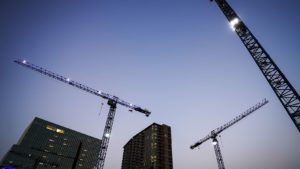 Commercial real estate projects supported more than 428,000 Texas jobs last year.
Commercial real estate projects supported more than 428,000 Texas jobs last year.
Even with the pandemic, commercial real estate development contributed more than $65 billion to the Texas economy in 2020.
That’s more than any other U.S. state, according to an annual study by a top real estate trade group.
Texas enjoyed almost twice the economic impact from development of the other top states in the report by the NAIOP, the Commercial Real Estate Development Association.
The commercial property sector’s contribution to the state economy last year was up from the estimated $54 billion in 2019, despite the economic drag of the COVID-19 pandemic. Many commercial property projects were delayed our cancelled statewide because of the coronavirus outbreak.
Commercial development activities supported more than 428,000 Texas jobs last year, up from 380,000 the year before, according to the study.
Texas has long been a leader in the real estate sector in terms of jobs, construction and investment.
Nationwide development of projects including office, industrial, warehouse and retail in 2020 contributed $1.01 trillion to the U.S. economy and generated $338.1 billion in personal earnings, according to the NAIOP.
The industry’s strong showing last year came in the face of a more than 28% decline in new office and retail projects.
NAIOP researchers predict the commercial development market won’t return to prepandemic levels until 2022.
“Many factors point to a commercial real estate rebound in 2021,” Thomas J. Bisacquino, president and CEO of NAIOP, said in the report. “Obviously we dealt with several unknowns and an unexpected downturn in 2020; however, we believe that while the pandemic has accelerated trends already progressing in real estate, we have a bright future.
Office workers will return to the offices with some regularity in 2021, the industrial and warehouse sectors will continue to expand as e-commerce demand intensifies, and the retail sector will be reshaped as the shopping experience evolves.”


